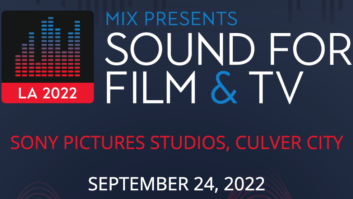ClearSonic’s standard Panel (CSP) features 1/4-inch thick panel in heights of 2, 3, 4 and 5.5 feet.
Providing balanced and pleasing sound in church settings can be a challenge. After all, one person’s “perfect” is someone else’s “too loud.” Since exorbitant stage levels are frequently the culprit in house-of-worship (HOW)-based SPL offenses—often resonating from typical backline instrumentation such as drums, amplified guitars and synths—fixing the problem on stage, at the source, is a most logical solution.
ISOLATING DRUMS/PERCUSSION
Acoustic drums still dominate the market, and most drummers still prefer to play the real deal. Yet in a HOW setting, excessive acoustic drum SPL will usually be a part of the problem, if not the problem entirely. In a HOW volunteer environment, performers are often accomplished amateurs at best, and a subset of such drummers will play too loud (and really can’t help it); accurate volume control while keeping the groove is generally an advanced skill. Drum isolation tools are a must in most HOWs hosting a drum kit, especially when playing to a demographically-broad congregation.

The most prominent brand in drum kit isolation tools is ClearSonic Manufacturing, Inc. of Hudson, OH. This company has been providing clear acrylic isolation gobos to pro drummers for decades. The company’s portable, hinged barriers are heavy but are the best solution for live drum isolation in the marketplace.
The standard ClearSonic Panel (CSP) is a quarter-inch thick crystal-clear panel in heights of 2, 3, 4 and 5.5 feet tall; 12 and 18-inch extenders are available, which can be configured into acrylic/absorptive fiberglass panel-comprised full enclosures.
A drummer myself, I bought a 5.5 ft., 5-panel CSP kit years ago and plan on using it forever. With it, I can play comfortably while better controlling overall stage volume. It’s also the least visually restrictive of any acoustic drum SPL control solution. It’s not cheap, though; it currently retails for well over $500.
Careful drum kit positioning will play a big part in controlling overall SPL, too. Avoid bass buildup by keeping the kit away from corners and solid rear walls. If placed near a wall or corner, absorptive wall-mounted products could be a worthwhile post-construction investment. I’ve had great success using Primacoustic’s Broadway absorptive fiberglass panels as well as MaxTrap (corner) and FullTrap (wall) bass traps combined with my CSP.
Of course, if an electronic drum kit is artistically and aesthetically acceptable, that’s a great solution. Before buying, any HOW should poll participating musicians on drum kit preferences, though. Tastes often lean toward a more overall “human” aural experience—hardly surprising in such a spiritual environment.
ISOLATING STRINGED INSTRUMENTS
Acoustic stringed instruments will generally have the opposite problem of acoustic drums when behind the pulpit: They’re hard to hear if not miked, aloft in a wash of reverberation in the rafters, or both. It’s best to discourage the use of acoustic guitar amps on a hot HOW stage. Instead, encourage the use of acoustic guitar pickups or provide acoustic instrument microphones, either mixed accordingly for both front-of-house and musician monitoring.
DPA’s d:vote 4099 Instrument Microphones are ideal premium microphone solutions for acoustic guitars and so on, and have proven quite effective in HOW applications. At $599 street with goose-neck and mounting clip, the VO4099-G supercardioid is a solid, versatile and great-sounding investment for such needs.
When featuring multiple acoustic instruments together, or any proper ensemble onstage, choosing a minimum microphone setup; often the best option is an omnidirectional condenser (for mono reinforcement) or a stereo microphone carefully placed in the sweet spot amongst the performers.
With electric guitar amps, ClearSonic offers a variety of AmpPacs, varying from simple small shields to fully-enclosed acrylic/fiberglass kits. These are useful to a certain extent, but mainly in affecting high and midrange frequencies, as such a solution often seems to “blanket” the sound, emphasizing woofy mid-low frequencies. Add to the equation other amps and a hollow, boxy resonant stage, and acoustic issues will multiply. In such instances, decoupling tools such as Auralex’s GRAMMA (Gig and Recording Amp and Monitor Modulation Attenuator) can be useful. GRAMMA models are built to float combo amps, big 4X12 cabinets, stage monitors, and more. At $69 street for the classic GRAMMA, it’s an affordable and effective sound accessory. For a bit more money, IsoAcoustics’ Modular Series isolation products are available as custom configurable aluminum units for a range of amp and cabinet sizes. Such decoupling tools can be effectively applied in the same manner to keyboard/synth speaker cabinets, too.
Like an electronic drum kit, an amplifier emulation system reduces stage volume in an incredibly helpful way—it eliminates an audible sound source altogether. More specifically, with mid-frequency dominant electric guitar, removing an open amp from the stage allows overall SPL to come down dramatically, allowing vocals and lyrics to be better heard and understood, too.
Line 6—of legendary POD fame—offers a variety of great-sounding amp modulation/effects units, with most featuring modern and user-friendly GUIs, dedicated knobs and foot pedals. Other great options are available from Roland, TC Electronic/TC-Helicon, Tech 21 and Vox, among others. Reasonable and readily available choices range from the Vox StompLab IG pedal at $69 street to the world-class, roadworthy TC Electronic G-System at well over $1,200 street.
ELIMINATING STAGE MONITORS
Of course, the best isolation tools are ideas that spring from an understanding of large room acoustics. With some solid reductionist thinking—such as choosing in-ear monitoring solutions over open wedges on stage—multiple acoustic improvements can be made in one fell swoop. As a result, performers will hear and blend more musically and the congregation will receive a clearer, cleaner and more deliberate sound.







